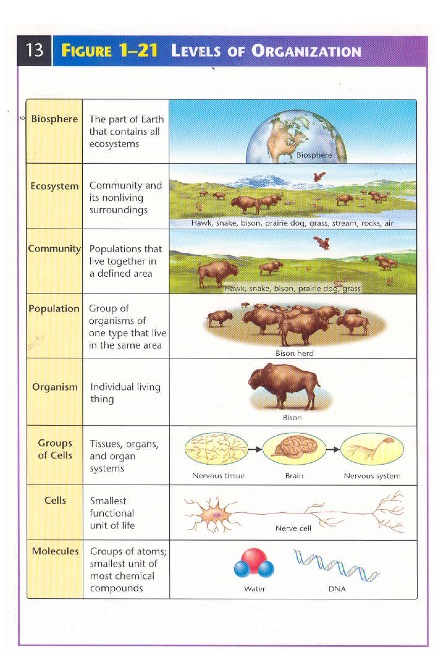| |||||||||||||||||||||||||||||||||||||||||||||||||||||||||||||||||||||||||||||||||||||||||||||||||||||||||||||||||||||||||||||||||||||||||||||||||||
|
login
|
|
||||
|
Page 2 - 28 Chapter 1 Lesson 1 What is Science? Science: is
an organized way of using evidence to learn about the natural world. Key Point: The goal of
science is to investigate and understanding the natural world, to explain
events in the natural world, and to use those explanations to make useful
predictions. Thinking like
a scientist Scientific
thinking usually begins with observation, the process of gathering
information about events or processes in a careful, orderly way. The
information gathered from observations is called data. Explaining
and Interpreting Evidence A hypothesis is
a proposed scientific explanation for a set of observation. Chapter 1 Lesson 2 Forming a
Hypothesis Scholars of
the day even gave a name to idea that life could arise from nonliving
matter spontaneous generation. Setting up a
Controlled Experiment Whenever possible, a
hypothesis should be tested by an experiment in which only one variable is
changed at a time. All other variables should be kept unchanged, or controlled. This type of
experiment is called a Controlled experiment. The variable that is
deliberately changed is called the manipulated variable. The variable that is
observed and that changes in response to manipulated variable is called the responding
variable. How a Theory
Develops As evidence from
numerous investigations builds up a particular hypothesis may become so well
supported that scientists consider it a theory. In science, the word
theory applies to a well-tested explanation that unifies a board range of
observations. Chapter 1 lesson 3 Biology is the science
that seeks to understand the living world. What are the
Characteristics of Living Things? Living things are made
up of units called cells. Living things
reproduce. Living things are
based on a universal genetic code. Living things grow and
develop. Living things respond
to their environment. Living things maintain
a stable internal environment. Taken as a group,
Living things change over time. A Cell is
a collection of living matter enclosed by a barrier that separates the cell
from its surroundings. In Sexual
reproduction, two cells from different parents unite to produce the
first cell of the new organism. In Asexual
reproduction the new organisms has a single parent. The Combination of
Chemical reactions through which an organism builds up or breaks down materials
as it carries out its life processes is called metabolism. A Stimulus is
a Signal to which an organism responds. The Process by which
they do this is called homeostasis. The ability of a group
of organisms to change over time is invaluable for survival in a world that is
always changing. The process is called evolution. Levels of Organization Biosphere Ecosystem Community Population Organism Group
of cells Cells Molecules Chapter 1 lesson 4 The Metric
system is a decimal system of measurement whose units are based on
certain physical standards and are scaled on multiples of 10. Microscopes, such
as the light microscopes in figures 1-25 are devices that produce magnified
images of structures that are too small to see with the unaided eye. Light
microscopes produce magnified images by focusing visible light rays. Electron
microscopes produce magnified images by focusing beams of electrons. Compound
light microscopes allow light to pass through the specimen and use two
lenses to form an image. Electron
microscopes is an microscopes that could look at smaller objects that you
can’t see with your eyes such as the one shown in figure 1-26 use beams of
electrons rather than light, to produce images. The cell is
able is to reproduce so that a group of cells, called a cell culture,
develops from the single original cell. Biologists often use a technique known as cell fractionation to separate the different cell parts. To refresh your memory please go to your biology book for the figures & pictures.
|
||


